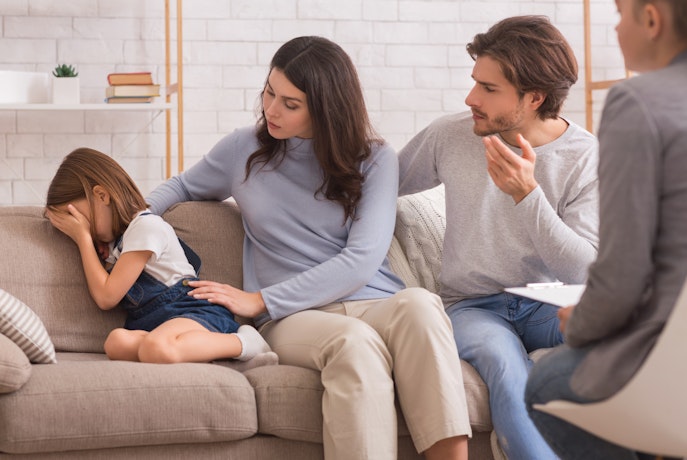It was a warm August evening as I entered the therapist's room with my 5-year-old foster child, Isabella, who found a comfy pillow and flopped it down on the single large seat she and I were sharing, placed close to her therapist's chair so the three of us could lean in together and see the computer screen, as her biological mother was Facetiming us from the rehabilitation center she'd been in for the past few weeks.
This was the start of one of the most heartbreaking moments I’ve ever endured as a foster parent. The three of us adults, who each loved Isabella in different ways, had come together to break the unfortunate news that her biological father had passed away. At that difficult moment, we were the adults who made up Isabella's village. We were only beginning to get to know one another, but in that moment, we acted in harmony, as if we were one.
When Isabella heard what had happened to her biological father, she froze. She sat there quietly for what felt like an eternity, holding all of her emotions in and avoiding my eyes. At last, when she looked up, it was as if she'd been waiting for me or her therapist or her biological mom to give her permission to make a sound, much less to release the full weight of the many feelings that were beginning to swirl around inside her.
As our eyes met, I pulled her close to me, and the floodgates opened. We cried. We all cried, and slowly, Isabella began to search for the words to begin to share what she was feeling. I was relieved to see the feelings chart we'd been using at home to navigate some tough moments together had made its way into my bag before we'd gotten in the car to head to therapy. Isabella was familiar with the many different feeling faces on the chart, and the familiar faces that looked a lot like how she was feeling were a small comfort. She let go of my waist with one hand, wiped her eyes, and then pointed to not one, but four different feeling faces on the poster before looking up at me for assurance that it was okay to be feeling not only sad, but also angry, confused, and worried.
As we three adult women sat with Isabella in her many mixed emotions, we made a point to each be not only a shoulder to cry on, but a listening, and accepting ear that she could begin to share not only her feelings, but also her thoughts, and the many questions that followed.
Imagine being a small child receiving this news after having been removed from your typical environment and placed with strangers ... all while still overcoming the recent trauma you have just endured. That's a lot of thoughts and emotions for anyone to manage no matter their age... and yet, this is a far too common reality for foster and adoptive children like Isabella.
Permission to Feel their Feelings
Regardless of what a child has been through or how they feel, we are determined to give them a space to experience, express, and release their emotions. This is a vital aspect of their emotional development and overall well-being.
When children are not only permitted but taught the skills they need to name and share their feelings, it helps them come to understand themselves and others, paving the way for healthier relationships as they grow. Moreover, when they are encouraged to talk about their feelings, they develop the ability to seek support and guidance when needed.
Providing a compassionate and safe environment where children can release their emotions, whether through play, creative expression, or simply being heard and validated, is crucial for their mental and emotional health. Ultimately, when children are empowered to feel, talk about, and release their emotions, they are better equipped to navigate the complexities of life with resilience.
Foster and adoptive parents are great catalysts for change in the lives of children, with the opportunity to nurture and help them grow into resilient, healthy, and compassionate individuals. For this reason, Generation Mindful® is partnering with family support organizations and foster families to ensure our early emotional learning tools and toys get into the hands of every child, especially those with a history of trauma, learning differences, and/or those impacted by poverty or racism.
Join The Village
At Generation Mindful®, we are committed to raising an emotionally healthy world... and to do this, it will take a village. This is why our online learning community is known as The Village. It offers complimentary access to Generation Mindful’s early emotional education and positive childrearing resources for parents, caregivers, and educators.
We have both a free membership level for educators and families to ensure access, as well as a paid membership level for those wanting to take a deeper dive into emotional learning and healing toxic generational cycles.
How to Join
Click on “The Village Member Login”
In the top right corner, click on “Sign In”
If you do not have an account, choose “Create an Account”
On the left-hand side, click on “Parent/Caregiver Hub” or “Educator Hub”
Parent/Caregiver Hub
After joining The Village, you will have access to a multitude of free resources. On the Parent/Caregiver Hub, you will first see a section explicitly dedicated to positive discipline, where you can view several videos.
Positive discipline encourages open dialogue, setting clear expectations, and teaching problem-solving skills, all of which contribute to the development of well-adjusted, self-disciplined individuals who are more likely to make positive choices and build strong relationships as they grow.
In this free learning portal, we offer access to a positive parenting introduction course, an introduction to time-ins and calming corners, a webinar on how to transform your triggers, setting boundaries, and more.



















